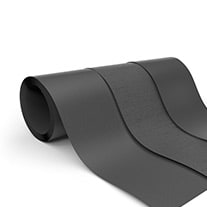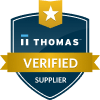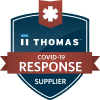| Butyl Rubber |
FR 134 |
1/16, 1/8 |
60 |
-40 to 180°F |
Black |
Isobutylene-isoprene |
- * Seals for vacuum applications
- * Tire inner liners and tubes
- * Hydraulic applications where synthetic fluids are used
- * many applications requiring an airtight rubber
- * Molded gaskets
- * Marine environments and electrical applications because of its above average tear resistance
|
- * Good flexibility while having excellent resistance to gas and steam permeation
- * excellent dielectric properties
- * Very good weathering resistance
- * High abrasion resistance
- * Low permeability to air
- * Poor flame resistance and cold flow characteristics are limited
- * Poor resistance to petroleum based fluids
|
| EPDM Rubber |
564 |
1/32, 1/16, 1/8, 3/16 |
50, 60 |
50 to 250 °F |
Black(in stock)), White |
Ethylene- Propylene- Diene Modified |
- * excellent general purpose gasket materials
- * Outdoor applications where weather, water, ozone, and UV rays resistance is required
- * used in the HVAC industry
- * Used for gaskets, bumpers, auto parts, weather stripping, and conveyor belts
|
- * Exceptional resistance to weather aging factors
- * Very good resistance to steam and oxygenated solvents
- * Not recommended for use with petroleum oils
|
| Neoprene Rubber |
FR124, FR129, FR135, FR153, FR154 |
1/16, 3/32, 1/8, 3/16, 1/4, 3/8, 1/2, 3/4, 1 |
40, 50, 60, 70 |
-20 to 190 °F |
Black |
Chloroprene |
- * Multi purpose
- * Refrigeration seals
- * Meets standards of mass transit industries
- * Bumpers, pads, sealing, and general gasket applications
|
- * Invented in 1930 as a substitute for natural rubber, and is the first synthetic rubber that is more resistent to water, oils, heat and solvents than natural rubber and its known for its versatility
|
| FR114 HIGHER GRADE |
1/32, 1/16, 1/8, 3/16, 1/4 |
50 |
-30 to 225 °F |
Isobutylene-isoprene |
- * Multi purpose
- * Refrigeration seals
- * Meets standards of mass transit industries
- * Bumpers, pads, sealing, and general gasket applications
- * Electrical insulation
|
- * *Excellent: tensile strength, abrasion resistance, and resistance to heat build up
- * Moderate resistance to ozone, oils, refrigerants, gasoline, and some chemicals
- * Adheres well to metals and fabric
|
| Nitrile (Buna-N) Rubber |
FR113 |
1/16, 1/8 |
60 |
30 to 250 °F |
Black |
NBR Butadiene, acrylonitrile |
- * General purpose oil-resistant used in fuel hoses, gaskets, rollers and other products in which oil resistance is required
- * Most widely used product for sealing due to its excellent resistance to petroleum products
- * Hydraulic applications where synthetic fluids are used
- * more than 50% of the o-rings sold are nitrile o-rings
- * hydraulic fluid applications
- * industrial and automotive applications such as transmission belts and hoses
- * disposable non-latex gloves
|
- * Excellent resistance to oil, gasoline, solvents, and hydraulic fluid
- * Good abrasion resistance
- * Poor resistance to concentrated Acids
|
| Natural Gum Rubber |
FR145 |
1/32, 1/16, 1/8, 3/16, 1/4, 3/8, 1/2 |
40 |
-20 to 180 °F |
Tan |
Isoprene, natural |
- * tires
- * Tubing
- * Gaskets
- * Belting
- * Vibration isolators
|
- * Crude natural rubber is found in the juices of many plants, after the latex is processed it becomes an elastomer
- * excellent flexibility and tear resistance
- * excellent resistance to water and cold flow
- * low compression set and bonds easily to a wide range of materials
- * poor resistance to sunlight, oxygen, ozone, UV rays, and high temperatures
|
| SBR Rubber |
FR162 (Red Sheet), FR142 (Chute Lining/ Skirtboard in pre-cut widths), FR146(Chute Lining/ Skirtboard in full width Rolls) |
1/16, 1/8, 3/16, 1/4, 3/8, 1/2, 1 |
45, 60, 70 |
-20 to 180 °F |
Red, Black |
Styrene- Butadiene |
- * Tire, tubes, gaskets, belts, hoses, seals, bumpers
- * many different industrial applications due to its long service life
- * Gaskets, seals, and o-rings
- * Jobs wanting a more physical aesthetic appeal
- * Excellent, low-cost, flange gasket material
- * Good electrical insulation
|
- * similar to natural rubber but has superior water, heat, and abrasion resistance
- * wide temperature range and typically odorless
- * Excellent resistance to high temperatures
- * Excellent vibration damping
|
| Silicone Rubber |
FR132 (sheet rubber), FR466(sponge) |
sheet rubber: 1/32, 1/16, 1/8, 3/16, 1/4 sponge: 1/8, 3/16, 1/4, 3/8, 1/2 |
sheet rubber: 50
sponge: Medium Density in stock (can be special ordered in soft or firm density) |
-80 to 500 °F |
Black, Red, Grey |
Polysiloxane |
- * Excellent vibration damping
- * Generally odorless and non-toxic
- * Excellent Gasket Material
|
- * Excellent high and low temperature properties
- * Poor tensile, tear, and abrasion resistance
- * FDA approved Ingredients
- * Low Compression Set
|
| Cork Rubber |
DC100, NC710 |
1/16, 1/8 |
Soft, Medium, and Firm Densities |
-40 to 250 °F |
Brown |
Cork, blended with a Buna, Nitrile, or Neoprene Rubber |
- * Sealing applications
- * Gaskets
- * noise reduction
|
- * Good compressibility
- * Good oil resistance
|
| Hypalon® Rubber (trademark of E.I. Dupont Inc) |
Not in stock but can be special ordered |
Not in stock but can be special ordered |
Not in stock but can be special ordered |
-20 to 220 °F |
Black |
Chloro-sulfonyl-polyethylene |
- * Used in whitewater rafts, containment suits, outdoor equipment
- * Used in single-ply roofing membrane
|
- * Noted for its resistance to chemicals, temperature extremes, and ultraviolet light
- * An extremely durable and waterproof elastomer
|
| PORON® Urethane Foam (trademark of Rogers Corp) |
4701 |
1/16, 1/8, 3/16, 1/4 |
Shore”O” <3, 8, 16 Shore “A” <3, 5, 12 [Density: 15, 20, 25, 30 (lb/cubic foot)] |
-60 to 250 °F |
Black |
Urethane Foam |
- * Enclosure Doors
- * Consumer Appliances
- * Automotive Interiors
- * Sealing and Gasketing
- * Impact Resistance
- * Protective Gear and Footwear
|
- * Elasticity
- * Good Chemical Resistance
- * Flame Retardant
- * Easy to work with
- * Will take adhesive coating
- * Poor moisture resistance
|
 Fournier Rubber supplies many different types of sheet rubber with a wide variation of thickness, hardness, and temperature range to meet any application you may need. Our sheet rubber can be sold in bulk by the roll, or to be cut to specific size by length and width, or to be Die-Cut into customized gaskets.
Fournier Rubber supplies many different types of sheet rubber with a wide variation of thickness, hardness, and temperature range to meet any application you may need. Our sheet rubber can be sold in bulk by the roll, or to be cut to specific size by length and width, or to be Die-Cut into customized gaskets.




